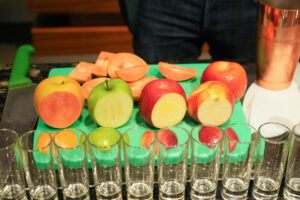FOR CENTURIES, the apple has captured the world’s imagination. In several languages, the word apple has become a substitute for the idea of fruit itself: the French name for potato, pomme de terre, translates to “apple of the earth,” while Italian’s pomodoro, the word for tomato, broken apart, means “apple of gold.” The Bible doesn’t say which fruit it was that Eve ate that caused humanity to be cast out from Eden, but art depicts it as an apple. The apple has so long been associated with temptation, that popular fairy tale character Snow White (almost) meets her end when she is tempted by one.
We got a taste of what it meant to be both Eve and Snow White on Nov. 13 at the Grand Hyatt, when we were tempted by the apples from Bonjour! French Food, a trade mission serving as an introduction to French apples by Interfel (France’s Interprofessional Association for Fresh Fruits and Vegetables) and the French Chamber of Commerce and Industry in the Philippines.
Daniel Sauvaitre, president of Interfel, was at table while his colleagues sliced apples for us. We passed on the familiar and tart Granny Smiths, taking a bite out of politeness. But we weren’t able to resist the temptation of the Candine: bright red, and very sweet (you must note that we have a fruit aversion, so eating more than half of the apple was a remarkable feat). They followed this up with slices of Juliet, a tiny apple with blushes of red on the inside, with a scent like perfume.
It was over for us when they cut up the Kissabel, first planted in the Loire Valley in 2018. It had a golden skin; rosy, pinkish flesh, and a taste that balanced candy-like sweetness with refined bitterness. If this were the fruit offered to either Eve or Snow White, we would have completely understood. We recall a line from animated comedy King of the Hill, when they first bit into organic tomatoes: “If this is food, what have we been eating?!”
Mr. Sauvaitre said that despite the multiple plant species that Interfel is concerned about, they’re concentrating now on bringing their apples to the Philippines. “With Interfel, we take care of more than 100 species. But it’s only apple that we are exporting far away from France,” he said.
Within the European continent, they trade in various other fruits and vegetables. Regions like Asia and South America get apples. “France… until 2000, we were the first country exporting apples in the world. We were the top,” he said. Today, they rest below the top five.
He listed the world’s top apple producers: China produces 44 million tons, followed by the US with five million. Other countries ranking above them include Poland, Turkey, Iran, and Italy. Last year, Mr. Sauvaitre said, France produced 1.5 million tons of apples, with 340,000 tons of those going to Southeast Asia and South America (another region they’re hoping to attract is India). “If we are able to sell more [apples], we will plant more,” he said.
The goal for French apples in supermarket shelves (part of the trade mission was to meet with retailers and importers) isn’t to topple the top fruit imports in the country. What they’re doing is introducing novelty. “It’s difficult for us to compete with China,” he said. “You put on the shelves some different varieties, different than what you already have. It’s difficult to compete with what you already get,” he said. — JLG
